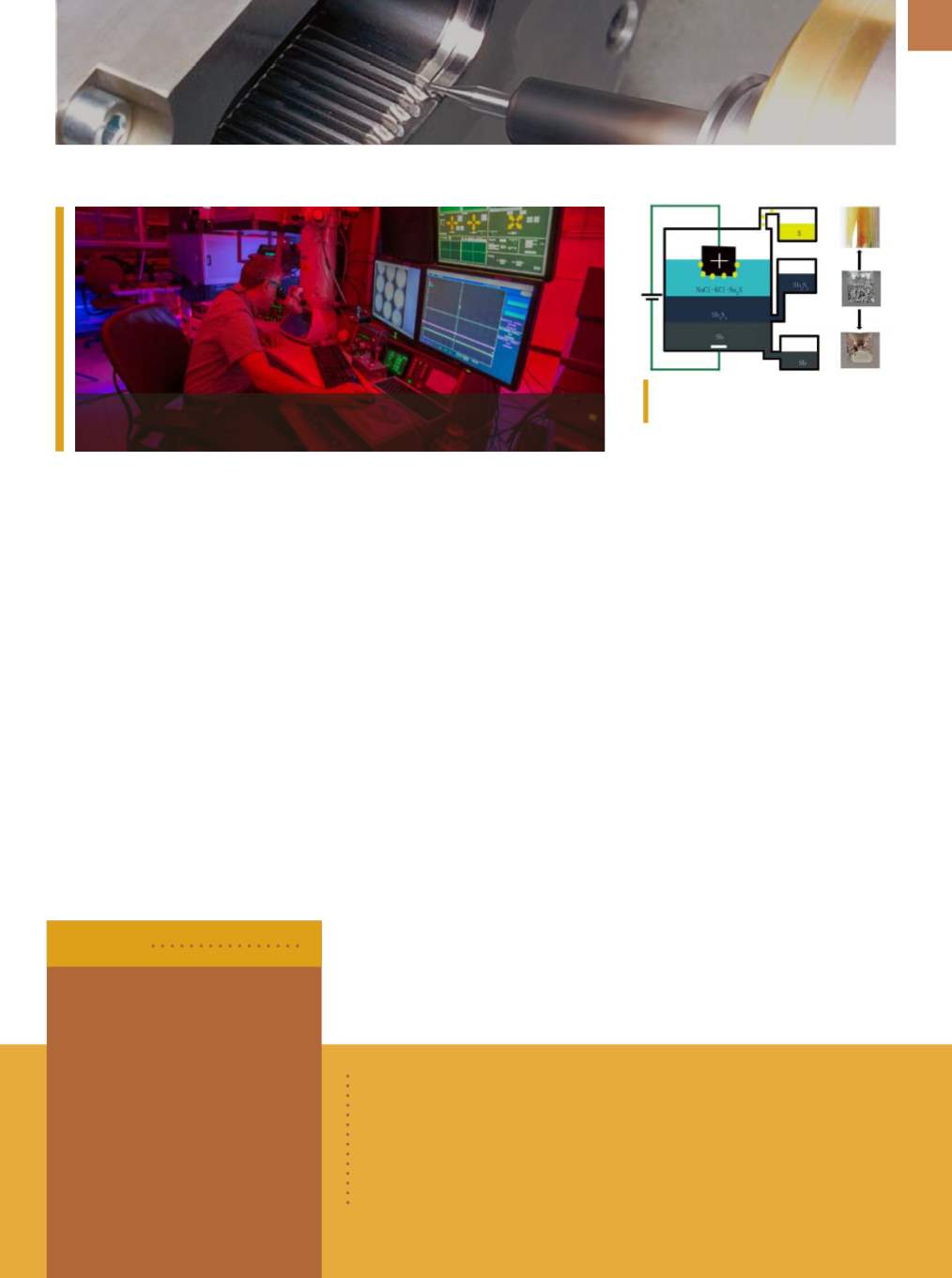

A D V A N C E D
M A T E R I A L S
&
P R O C E S S E S |
O C T O B E R
2 0 1 6
1 3
Joseph McKeown uses LLNL’s DTEM to investigate rapid alloy solidification. Courtesy
of Julie Russell/LLNL.
IMAGING ALUMINUM ALLOY
SOLIDIFICATION
Engineers at the University of
Pittsburgh are focusing the power of a
dynamic transmission electron micro-
scope (DTEM) on rapid solidification of
aluminum alloys associated with laser
or electron beam processing technolo-
gies. Unlike a traditional transmission
electron microscope, the DTEM at Law-
rence Livermore National Laboratory
(LLNL), Calif., uses lasers to achieve
high time resolution, allowing research-
ers to see how a chemical reaction,
structural deformation, or phase trans-
formation takes place with an unprece-
dented combination of spatial and tem-
poral resolution—in nanometers and
nanoseconds.
“DTEM allows you to see the in-
terface between the solid and liquid
Electrolysis of a molten semiconductor.
Courtesy of the researchers.
during rapid solidification,” says Joe
McKeown, an LLNL materials scientist.
“We can image this process as it’s mov-
ing rapidly, and from that we can mea-
sure just how fast it’s going. There’s no
other technique to do that.” Previously,
these transformations could only be
simulated on a computer. McKeown
said the data collected from the study,
funded by a three-year, $500,000 grant
from the National Science Foundation,
could improve predictive capabili-
ties for metal additive manufacturing
and validate existing computer models.
pitt.edu, llnl.gov.
SURPRISE! BATTERY MAKES
99.9%PURE METAL
While attempting to develop
new electrochemistry for a battery, re-
searchers at Massachusetts Institute of
Technology (MIT), Cambridge, instead
discovered an innovative method for
producing antimony. During experi-
ments with all-liquid, high temperature
storage batteries, composed of layers
of molten metals or salts, researchers
placed a second electrolyte—in this
case, antimony sulfide—between the
positive and negative electrodes. When
they attempted to charge the battery,
liquid antimony was produced instead.
Antimony sulfide is a good conductor
of electrons and normally would not
allow for electrolysis, which demands
an ionic conductor. However, electrol-
ysis was facilitated by adding an ionic
conductor layer on top of the molten
semiconductor.
The process formed a pool of
99.9% pure antimony at the bottom of
the cell, while pure sulfur gas pooled
at the top, where it could be easily col-
lected. In typical smelting processes,
sulfur gas bonds with oxygen in the
air to form sulfur dioxide—the major
cause of acid rain—requiring subse-
quent scrubbing. As a single-step con-
tinuous process, electrolysis is much
more efficient than traditional heat-
based smelting, and if used to produce
other common industrial metals such
as copper, nickel, or steel, could dra-
matically lower metal prices and re-
duce air pollution and greenhouse gas
emissions.
mit.edu.
Kobelco Aluminum Products &
Extrusions Inc.,
Japan, a sub-
sidiary of
Kobe Steel Ltd.,
broke
ground on its production facility
in Bowling Green, Ky., where the
company will manufacture alumi-
num bumper and car frame materi-
al for the U.S. automotive industry.
Fabrication will begin in late 2017,
with melting to extrusion processes
coming online in late 2018.
kobelcocm-global.com.
BRIEFS
The Shagang Group,
China, signed a licensing agreement with
Cas-
trip LLC,
Charlotte, N.C., to use Castrip technology in conjunction with
existing steelmaking furnaces for casting and finishing high strength, thin
gauge sheet, with widths to 1600 mm and gauges from 0.7-1.9 mm. Esti-
mated annual capacity is 500,000 tons per line, and hot commissioning
of the new facility is scheduled for late 2017. The Castrip process will
reduce energy use and emissions in the casting and rolling process.
sha-steel.com/eng, castrip.com.
PROCESS TECHNOLOGY
















